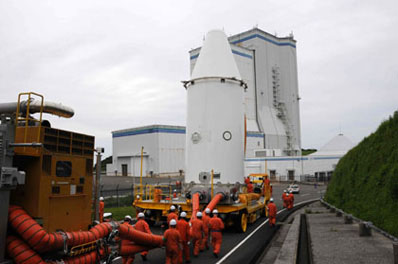Japanese Rocket Prepared to Launch Venus Probe and Solar Sail

An interplanetary weather satellite bound for Venus and adevice to test new propulsion techniques were trucked across Japan's islandspace center Sunday to meet the H-2A rocket that will launch the payloads intospace next week.
Cocooned inside the launcher's nose shroud, the payloads wereloaded onto a trailer and driven less than a mile from a checkout facility tothe Vehicle Assembly Building at the Tanegashima Space Center's Yoshinobulaunch complex.
Once inside the VAB, the nearly 40-foot-tall fairing waslifted atop the H-2A rocket and firmly bolted to the booster.
After engineers complete testing of the rocket, the 17-storyvehicle will roll on rail tracks about 1,500 feet to the launch pad nextMonday. Once the rocket arrives at the launch pad, workers will load liquidhydrogen and liquid oxygen propellant into the H-2A's first and second stages.
Flying for the 17th time, the H-2A rocket on this missioncarries a pair of powerful solid rocket boosters and no smaller strap-onmotors. This configuration is called the "202" version.
Liftoff is scheduled for exactly 2144:14 GMT (5:44:14 p.m.EDT) Monday from Launch Pad No. 1 at Tanegashima. The rocket must launch at aprecise instant each day to reach the trajectory toward Venus.
The launch will occur at 6:44 a.m. local time atTanegashima, a narrow strip of land off the coast of Japan's Kyushu Island, thesouthernmost of the country's four largest land masses.
Get the Space.com Newsletter
Breaking space news, the latest updates on rocket launches, skywatching events and more!
About the size of a small car, the Akatsuki spacecraftarrived at the launch site March 19 to begin final testing and fuelingoperations. The Ikaros solar sail, a secondary payload, was shipped toTanegashima in early April.
The 1,100-pound Venusprobe was attached to an apparatus containing Ikaros and other small satellitesApril 30. The payloads were encapsulated inside the fairing May 4.
Akatsuki should reach Venus by December if it gets off theground during a planetary window stretching between May and June. Akatsuki willcarry six instruments to study the Venusianatmosphere from its outer boundary with space to the planet's hellishsurface.
The probe will enter an equatorial orbit around Venusstretching from just above the planet's blanketing atmosphere to an altitude ofnearly 50,000 miles. It will be ideally placed to observe the whipping windsthat drive massive storm systems in the Venusian atmosphere.
Ikaros will be released on the same course as Akatsuki, butits mission will be to demonstrate applying light pressure from the sun as asource of interplanetary propulsion. Although never before tested in deepspace, solarsails could provide efficient propulsion for future missions travelingbetween planets and stars.
- JapanCould Put a Human(oid) on the Moon by 2015
- ImageGallery: Postcards from Venus
- SolarSails Could Clean Up Space Junk
Join our Space Forums to keep talking space on the latest missions, night sky and more! And if you have a news tip, correction or comment, let us know at: community@space.com.
Stephen Clark is the Editor of Spaceflight Now, a web-based publication dedicated to covering rocket launches, human spaceflight and exploration. He joined the Spaceflight Now team in 2009 and previously wrote as a senior reporter with the Daily Texan. You can follow Stephen's latest project at SpaceflightNow.com and on Twitter.









